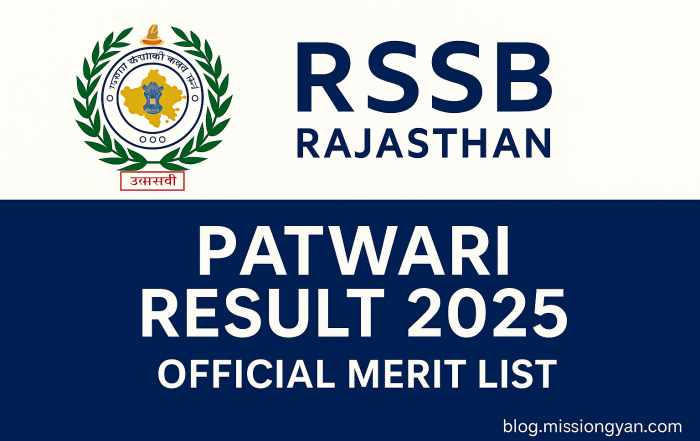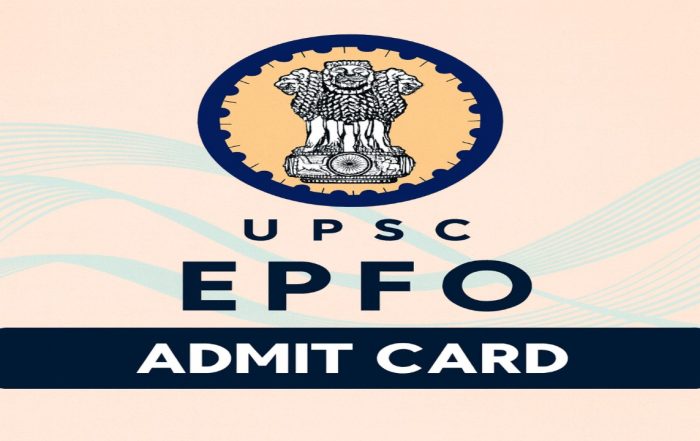RECENT POSTS
कक्षा 10 विज्ञान अध्याय 5: जैव प्रक्रम (Life Processes) – महत्वपूर्ण नोट्स, MCQs व प्रश्न-उत्तर
कक्षा 10 विज्ञान: अध्याय 5 – जैव प्रक्रम – महत्वपूर्ण नोट्स एवं प्रश्न-उत्तर जैव प्रक्रम परिचय— 1.जैव प्रक्रम — ➠सभी प्रक्रम जो सम्मिलित रूप से अनुरक्षण का कार्य करते हैं। a. पोषण: ऊर्जा स्त्रोत को [...]
UPSSSC PET Result 2025 Out: Download Scorecard & Cutoff
UPSSSC PET Result 2025 Released — Check Scorecard & Cutoff Here The Uttar Pradesh Subordinate Services Selection Commission (UPSSSC) has officially announced the PET Result 2025 on 05 December 2025. Candidates who took the exam on 06 & 07 September 2025 can [...]
🎯HSSC CET Result 2025 OUT – Download Group C Scorecard & Check Cut Off
🎯HSSC CET Result 2025 OUT – Download Group C Scorecard & Check Cut Off The Haryana Staff Selection Commission (HSSC) has officially released the HSSC CET Result 2025 for Group C posts on 05 December [...]
Rajasthan RSSB Patwari Result 2025 Out – Check Merit List PDF
🎯Rajasthan RSSB Patwari Result 2025 Declared – Download Merit List PDF & Check Next Process The Rajasthan Staff Selection Board (RSSB) has officially declared the Rajasthan Patwari Result 2025 for candidates who appeared in the [...]
SBI SO Recruitment 2025 🔔: 996 Vacancies Apply Online
🏦 SBI SO Recruitment 2025 ✅ – Apply Online for 996 Posts Notification State Bank of India (SBI) has officially released the SBI SO Recruitment 2025 Notification for 996 Specialist Officer vacancies including VP Wealth [...]
SSC GD Constable 2026 Notification, Vacancy & Apply Online Guide
SSC GD Constable 2026 Notification🎓 The SSC GD Constable 2026 recruitment is a national-level examination conducted to recruit candidates for various Central Armed Police Forces and other government organizations. Candidates who have passed Class 10 [...]
CTET 2026 Notification Apply Online, Eligibility & Fees
CTET 2026 Notification 📢 Apply Online for February Exam The Central Board of Secondary Education (CBSE) has officially released the CTET 2026 Notification for the February session. If you dream of becoming a government teacher [...]
NIOS April 2026 Registration Begins: Apply Online Now
NIOS April 2026 Registration Open 🎉 | Class 10 & 12 Students Apply Now The National Institute of Open Schooling (NIOS) has officially opened the registration and fee payment window for the April 2026 exams [...]
CSIR NET 2025 Notification: December Exam Date, Eligibility, Fee & How to Apply
CSIR NET 2025 Notification Out 🚀 The National Testing Agency (NTA) has released the CSIR UGC NET December 2025 Notification, confirming the exam date as 18 December 2025.This national-level exam determines eligibility for JRF, Assistant [...]
UPSC EPFO Admit Card 2025: Download Hall Ticket Now
UPSC EPFO Admit Card 2025: Download Your Hall Ticket Soon 🎫 The Union Public Service Commission (UPSC) will release the UPSC EPFO Admit Card 2025 soon on its official website: www.upsc.gov.in. The UPSC EPFO APFC [...]










